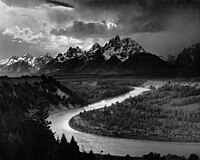
Photo from wikipedia
Abstract Meandering rivers have dynamic evolution characteristics of lateral migration and longitudinal creeping movement, and studies on the migration rate of meandering rivers have both scientific and practical significance for… Click to show full abstract
Abstract Meandering rivers have dynamic evolution characteristics of lateral migration and longitudinal creeping movement, and studies on the migration rate of meandering rivers have both scientific and practical significance for understanding the evolution process. A river source region often is sparsely populated and lacks long-term monitoring data, making it difficult to estimate the migration rate of river bends. In the source region of the Yellow River, located in the northeastern part of the Qinghai-Tibet Plateau, China, meandering rivers have extensively developed. Combined with field investigation and sampling in the source region in 2016 and 2017, 9 river bends in the middle Baihe River were selected to attempt estimation of migration rates of the river bends using tree ring analysis. The tree core and disc samples were collected using an increment borer and a crosscut saw, and the ages of the trees were estimated based on tree ring analysis. A method for estimating the migration rate of river bends based on the relation between positions and ages of trees grown on the point bars in inner banks is proposed. The estimated migration rates of the 9 river bends of the Baihe River ranged 0.38-6.10 m/yr, and the migration rates were found to be related to the flow rate, channel slope, height of the outer bank, and width of the river valley. The maximum migration rate was determined to be at the No. 9 River Bend where the ratio of the meander-bend radius to the channel width (R/W) was 2.31, which is consistent with previous findings that the bend migration is most rapid in the ‘migration phase’. The proposed method for estimating the migration rate of river bends provides a potential alternative option for future study on the morphodynamic process of a meandering river.
Journal Title: International Journal of Sediment Research
Year Published: 2021
Link to full text (if available)
Share on Social Media: Sign Up to like & get
recommendations!